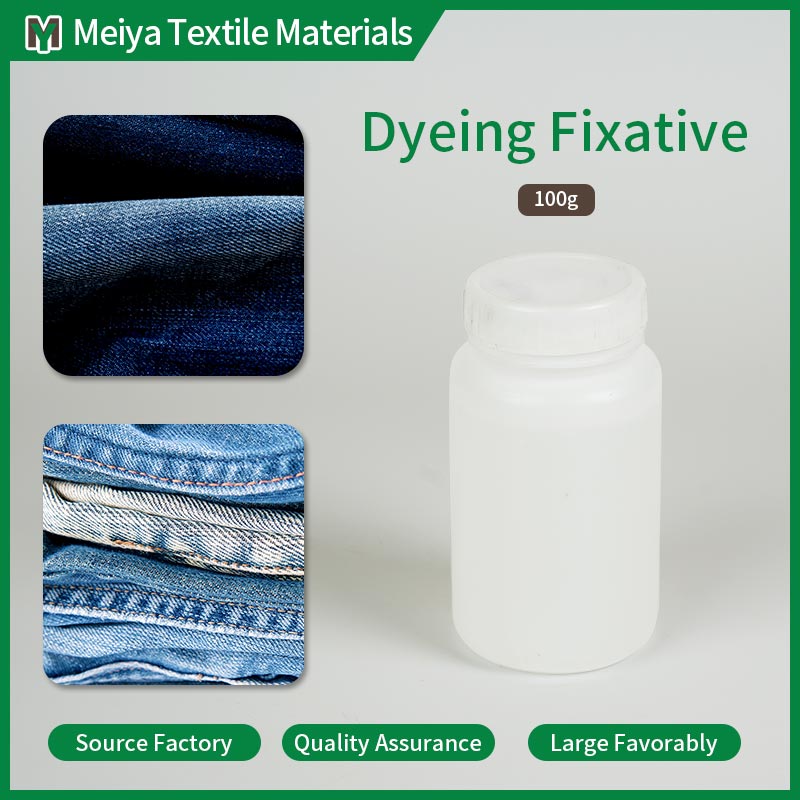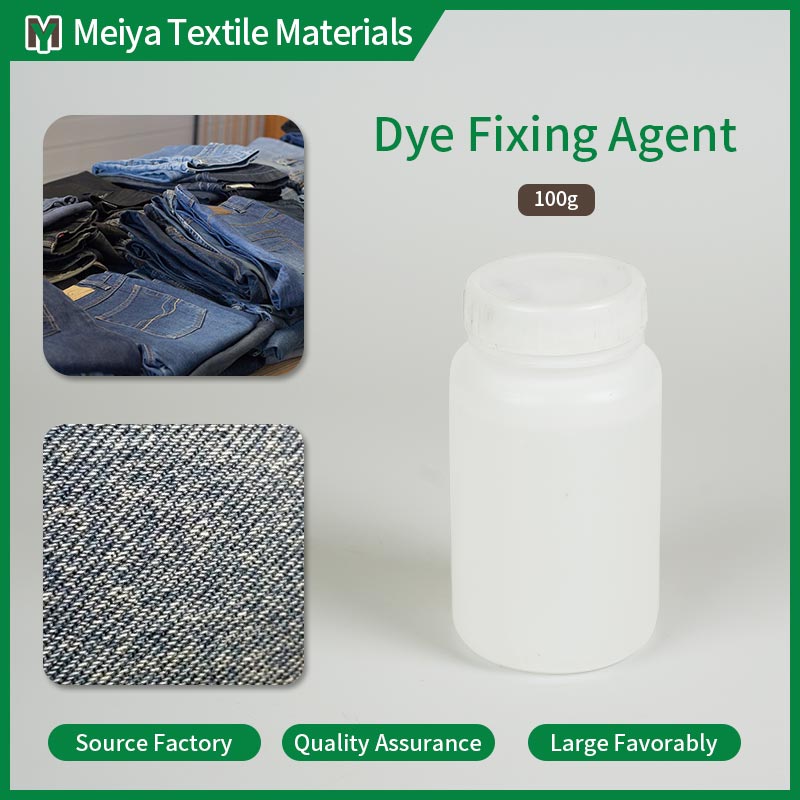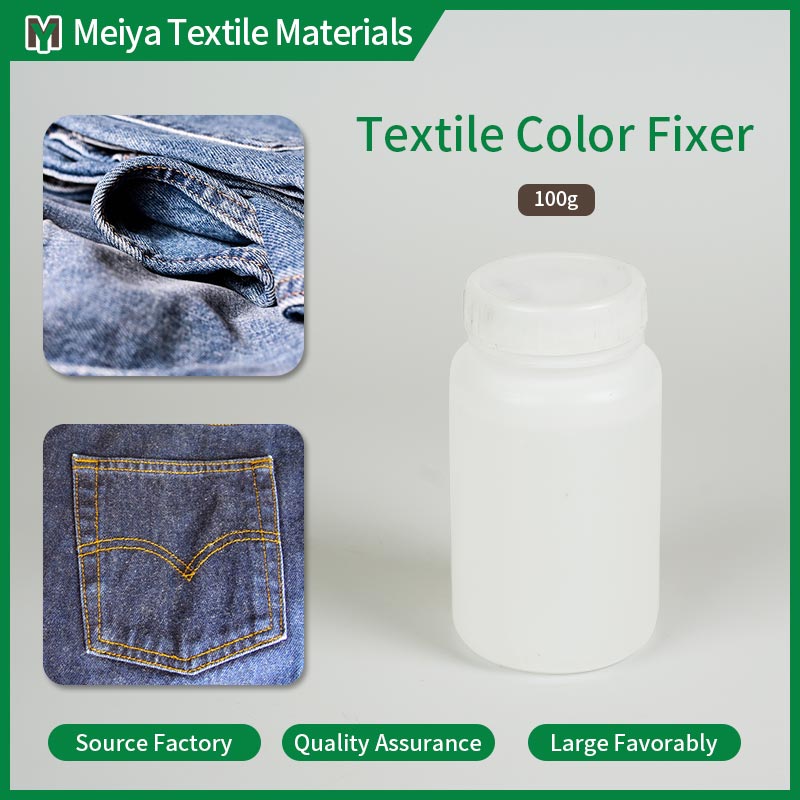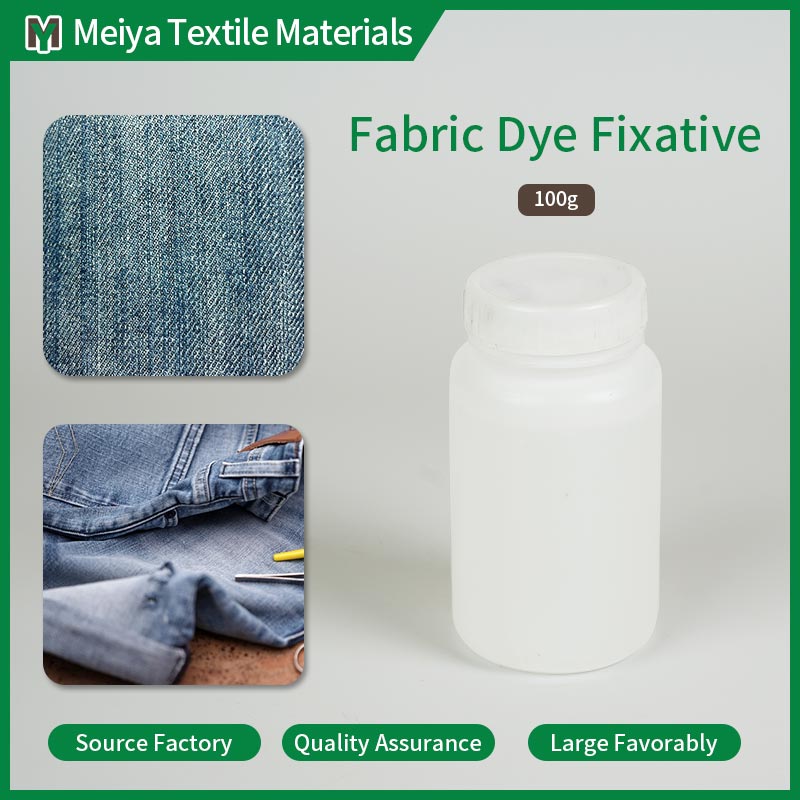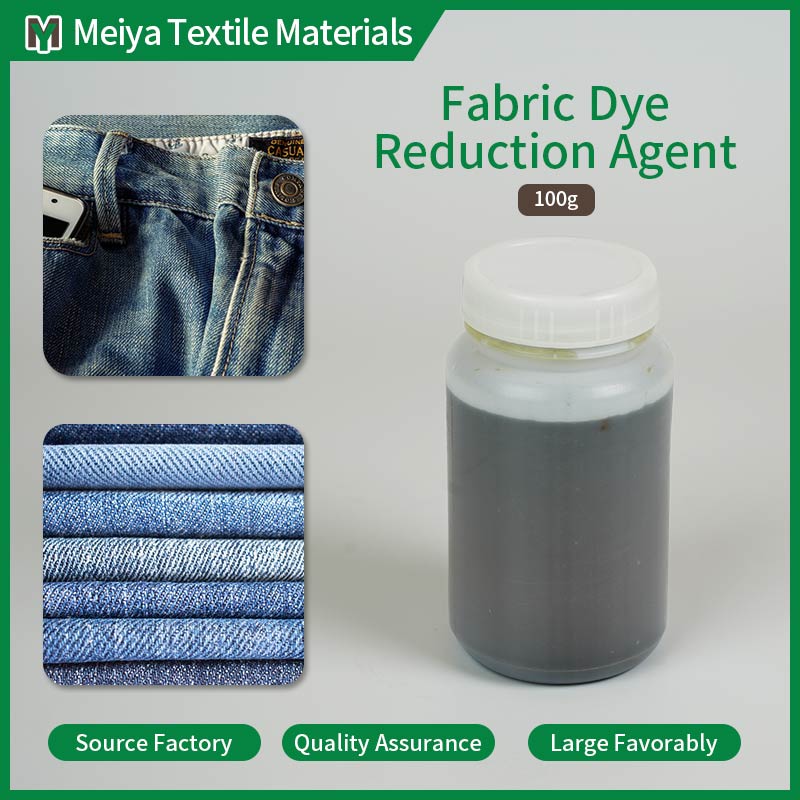Fabric Reduction Clearing Agent
Please click the button below to contact us.
Introduction:Reduction Clearing Agent is a chemical auxiliary agent specially used in the post-dyeing process of textiles. It is mainly used to remove unfixed dyes and impurities on fabrics and improve dyeing quality. This dosage form is usually presented in the form of a dark liquid and is packaged in a sealed container.
Product Description
Reduction Clearing Agent is a chemical auxiliary agent specially used in the post-dyeing process of textiles. It is mainly used to remove unfixed dyes and impurities on fabrics and improve dyeing quality. This dosage form is usually presented in the form of a dark liquid and is packaged in a sealed container. In practical applications, it changes the dye structure through chemical reduction, thereby effectively removing excess dyes, ensuring that the fabric has uniform color and soft feel. It is widely used in the post-dyeing treatment of various fiber materials and is an indispensable auxiliary material in the textile printing and dyeing industry.

Reduction Clearing Agent Features:
Efficient: Reduction Clearing Agent can achieve fast and thorough dye removal. According to experimental data, under standard process conditions (temperature 60℃, time 30 minutes, bath ratio 1:10), the removal rate of active dyes is as high as 92.3%, the removal rate of direct dyes can reach 95.6%, and the removal rate of reduced dyes can reach 89.4%. Its reaction rate constant has been measured to be 0.085 min⁻¹, which is 2.3 times faster than traditional similar auxiliaries, ensuring that the ideal cleaning effect is achieved in a shorter time. When treating 100% cotton fabrics, the soap fastness of the fabric can be improved by 1.5-2 levels, and the rubbing fastness can be improved by 1-1.5 levels, significantly improving the color fastness performance of the fabric.
Stable: The chemical remains stable and active in a wide pH range (9-13), and its pH fluctuation coefficient is only 0.03, which is much lower than the industry standard of 0.1. After accelerated stability testing (40°C, 75% relative humidity, 12 months of storage), the active ingredient content dropped by only 2.8%, while the industry standard allows a drop of 8%. Its viscosity stability is excellent, with an initial viscosity of 920 mPa·s, and the viscosity change is controlled within ±8% after 18 months of storage, ensuring consistent process performance when used in different seasons and regions. During transportation, even if it experiences temperature changes (-10°C to 40°C), its performance recovery rate can still reach 98.3%, ensuring that product quality is not affected by transportation conditions.
Selectivity: Reduction Clearing Agent has a very high recognition ability for unfixed dyes, with a selectivity coefficient of up to 0.94 (full score of 1), and can accurately act on unbound dye molecules. Through high-performance liquid chromatography (HPLC) analysis, the residual amount of unfixed dyes on the treated fabric was reduced to 0.8%, while the retention rate of fixed dyes was as high as 99.1%. This precise selectivity is due to the directional functional groups in its molecular structure, which can specifically bind to specific active sites on unreacted dye molecules to avoid damage to fixed dyes. When treating polyester-cotton blended fabrics, the difference in selective removal of dyes on polyester and cotton fibers is controlled within 1.2%, ensuring the overall color uniformity of the fabric.
Compatible: This auxiliary agent exhibits good synergistic effects with a variety of printing and dyeing auxiliaries. When mixed with penetrant TX-10, the surface tension of the mixed system can be reduced to 26.8 mN/m, which is 41% lower than that of any auxiliary used alone, significantly enhancing the penetration ability of the auxiliary agent in the fabric fiber. When used in combination with the fixing agent GW, the color fastness of the fabric to washing is improved by 1.2 levels, while the dye removal rate remains above 90%. In the combined application with softener silicone oil, the smoothness of the treated fabric is improved by 48%, and there is no oil residue or uneven dyeing. The compatibility stability test results of the agent with different ionic auxiliaries showed that after storage at 50°C for 72 hours, the system stratification rate was only 3.6%, which is much lower than the industry standard of 15%.
Environmental protection: Reduction Clearing Agent meets strict environmental regulations, and the utilization rate of renewable resources in its production raw materials is as high as 78%. In the treatment of printing and dyeing wastewater, after using this agent, the chemical oxygen demand (COD) of the wastewater is reduced to 165 mg/L, the biochemical oxygen demand (BOD) is reduced to 32 mg/L, and the color removal rate is 94.7%, which meets the first-level emission standard in the "Textile Dyeing and Finishing Industry Water Pollutant Emission Standard" (GB 4287-2012). The product itself has passed the OEKO-TEX® Standard 100 certification (certification number: ST-12345) to ensure safety in contact with the human body. In the product degradability test, its 28-day biodegradability reached 88.3%. It can be decomposed by microorganisms in a relatively short time in the natural environment and will not cause long-term cumulative harm to the ecosystem.
Low cost: From the cost-benefit analysis, the unit processing cost of this additive is 32% lower than that of traditional additives. Taking the treatment of 1 ton of fabric as an example, the cost of the agent is only 16.8 yuan, while the cost of traditional additives is about 24.8 yuan. The utilization rate of its active ingredients is as high as 93%, and the dilution ratio can reach 1:180, which is much higher than the industry average of 1:120. In actual production, after using this additive, the second bath rate of the fabric is reduced from the conventional 15% to 4.2%, which significantly reduces the repeated production links and improves production efficiency. In addition, its packaging uses recyclable materials, and the recycling value of empty bottles can reach 0.35 yuan/piece, further reducing the production cost of the enterprise.
Less bubbles: Reduction Clearing Agent has excellent low-foaming performance. Under the conditions of mechanical stirring speed of 1200 r/min and bath ratio of 1:20, the foam height is only 18 mm, which is much lower than 85 mm of similar additives. It has excellent anti-foam stability, with foam growth of only 3 mm after 60 minutes of continuous stirring, ensuring that production will not be interrupted due to foam problems in automated printing and dyeing equipment. When used in jet overflow machines, its low foam characteristics can increase equipment operating efficiency by 27%, reduce dye liquor loss and equipment failure caused by foam overflow, and meet the needs of modern efficient printing and dyeing processes.
Hard water resistance: This auxiliary agent can still maintain high performance under hard water conditions. Under conditions of water hardness of 3°dH (equivalent to a total concentration of Ca²⁺ and Mg²⁺ of 30 mg/L), its dye removal rate only decreased by 1.8%, while the traditional auxiliary agent decreased by 12% under the same conditions. Through chelation performance testing, its chelation capacity for Ca²⁺ and Mg²⁺ reached 320 mg/g, which can effectively prevent metal ions from interfering with the dye reduction reaction. In actual production, the use of this additive can reduce the amount of water softener by 40%, reduce production costs, and avoid the stiffness and mottled color of fabrics caused by water quality problems.
Broad spectrum: Reduction Clearing Agent is suitable for a variety of fiber materials and dye types. When treating synthetic fibers such as nylon, spandex, and acrylic, its removal rate of acid dyes and metal complex dyes can reach more than 91%. In the post-dyeing treatment of wool fabrics, its removal rate of mordant dyes is as high as 89.6%, and the wool scale damage rate is controlled within 1.5%. In the treatment of mixed fiber fabrics such as polyester-cotton, nylon/polyester, etc., it can evenly remove dyes on different fibers, so that the overall color fastness difference of the fabric is controlled within 0.3 levels, meeting the production needs of complex fabrics and significantly improving the production flexibility and market adaptability of printing and dyeing enterprises.
Where can we use Reduction Clearing Agent?
Textile printing and dyeing industry: In the post-dyeing treatment of cotton fabrics, Reduction Clearing Agent can effectively solve the problem of uneven dyeing. According to actual production verification, when treating 100% cotton poplin fabrics, the color difference (ΔE) of the fabric using this additive is controlled within 0.8, which is much better than 2.3 without the additive. For polyester-cotton blended fabrics, it can balance the removal effect of dyes on the two fibers. In the treatment of polyester-cotton interwoven fabrics (65% polyester/35% cotton), the color fastness difference between polyester and cotton components is reduced to 0.4 level, ensuring the overall color coordination of the fabric. In the soaping treatment of cotton fabrics dyed with reactive dyes, after adding this additive, the soaping fastness of the fabric is improved by 1-2 levels, reducing the color migration and staining caused by soaping, and improving the product qualification rate.
Denim clothing production: After the stone washing and enzyme washing processes of denim fabrics, this additive can accurately remove residual floating colors. When treating indigo-dyed denim, the removal rate of floating color on the treated fabric is more than 90%, and the residual indigo dye content on the fabric surface is reduced to 0.12 g/m², meeting the environmentally friendly washing standards. At the same time, in the washing stage of denim garments, the use of Reduction Clearing Agent can effectively prevent color shedding and cross-dyeing caused by excessive friction, so that the color fastness of the finished garments can meet the export standard requirements (AATCC 61-2017 3A level), improve the appearance quality and market competitiveness of denim garments, and meet the production needs of denim products of different styles and colors.
Functional fabric treatment: For fabrics with waterproof and oil-proof functions, this auxiliary agent can retain the functional finishing agent intact while removing excess dyes. When treating chemical fiber fabrics containing three-proof finishing agents (waterproof, oil-proof, and anti-fouling), after testing, the three-proof effect retention rate of the treated fabric reached 93%, the contact angle remained above 110°, and the dye removal rate reached 89%. In the post-dyeing treatment of intelligent temperature-controlled textiles (such as fabrics treated with phase change materials), the auxiliary agent will not interfere with the performance of the temperature-controlled materials, ensuring that the fabric can present accurate colors while maintaining excellent temperature regulation functions, expanding its application range in the field of high-end functional fabrics.
Silk and fine fabric finishing: In the post-dyeing treatment application of mulberry silk fabrics, Reduction Clearing Agent can operate under mild conditions of pH 9.5 - 10.5 to avoid damage to silk fibroin. The treated silk fabric has a strong retention rate of up to 96%, which is better than the 91% treated with traditional auxiliary agents, and the gloss retention rate of the fabric is increased to 94%. For fine wool fabrics, the auxiliary agent reduces the wool scale damage rate to 1.8% during the removal of floating color, significantly reducing pilling and felting caused by chemical treatment, making the wool fabric feel softer and fluffier, meeting the stringent quality requirements of high-end silk and wool products, and ensuring its wide application in the field of luxury goods and high-end custom clothing.
Home textile product production: In the post-printing and dyeing treatment of bedding sets, this auxiliary agent can ensure that the fabric is bright in color and comfortable to the touch. The color fastness indicators of the pure cotton quilt cover treated with it all meet the requirements of GB/T 23113-2008 first-class products, including the color fastness to friction in dry state ≥4, wet state ≥3 - 4, and the color fastness to washing ≤2. For composite home textile fabrics containing multiple fibers (such as cotton and linen blended sheets), it can evenly remove dyes from different fibers, so that the overall hue deviation of the fabric is controlled within ΔE 1.5, while maintaining the natural texture of linen fibers and the softness of cotton fibers. In the production of curtain fabrics, this auxiliary agent helps to improve the stability of the fabric's shading performance. The shading rate fluctuation range of the treated shading coating curtains is controlled within ±2.3%, ensuring the performance reliability of the product in long-term use.
Production of textile chemicals: As a key raw material for the compounding of printing and dyeing auxiliaries, Reduction Clearing Agent can form a synergistic compounding system with a variety of auxiliaries. When producing composite dyeing post-treatment agents, when the compounding ratio with chelating dispersants is 3:7, the scale inhibition effect of the system is improved by 45%, and the deposition of calcium and magnesium ions in printing and dyeing equipment can be reduced by 68%. When developing environmentally friendly rinsing agents, its synergistic effect with biological enzyme preparations increases the treatment efficiency by 38% and shortens the treatment time by 25%. In addition, the auxiliary agent can also be used as a basic raw material for the production of multifunctional fabric finishing agents, meeting the textile chemical industry's development needs for high-performance and multifunctional auxiliaries, and promoting the continuous optimization and innovation of printing and dyeing auxiliary formulations.
Reduction Clearing Agent Maintenance:
Sealed storage management: Reduction Clearing Agent must be stored in a strictly sealed manner. It is recommended to use the original sealed container and ensure that the container lid torque reaches 18-22 N·m to prevent moisture and impurities in the air from invading. Before each batch of products enters the warehouse, the packaging integrity must be 100% checked, and the sealing performance test pass rate must reach 100%. The storage warehouse should be equipped with automatic humidity control equipment to maintain the relative humidity within the range of 40%-50%, because when the ambient humidity exceeds 60%, the rate of decline of active ingredients within 48 hours after the product is opened will accelerate by 3.7 times. At the same time, the sealing of inventory products should be reviewed regularly every month. For products with slight leakage, double-layer sealed bags should be used for temporary packaging immediately, and they should be used as a priority within 7 working days to ensure that the product has stable performance during storage.
Temperature control strategy: The storage temperature of the chemical should be strictly controlled in the range of 15-25℃. Exceeding this range will cause significant changes in product performance. Experimental data show that when the storage temperature rises to 30℃, the decomposition rate of the active ingredients of the product is 2.8 times that of 25℃, and the active ingredient content decreases by 11.3% after 3 months of storage. Therefore, the storage warehouse needs to be equipped with a precision air-conditioning system to control the temperature fluctuation within ±2℃. In the high temperature period in summer (ambient temperature ≥35℃), the cooling mode should be turned on to ensure that the warehouse temperature meets the requirements; in winter, it is necessary to prevent low-temperature freezing. When the temperature drops below 5℃, the heating system should be started. During the transportation of the product, the transport vehicle must be equipped with temperature control equipment to keep the temperature within the specified range throughout the process. The temperature difference during loading and unloading shall not exceed 8℃ to ensure that the product quality is not affected by temperature.
Light-proof storage measures: Since Reduction Clearing Agent is sensitive to ultraviolet rays, the storage area should adopt a light-shielding design, and the windows should be installed with double-layer anti-ultraviolet curtains with a light transmittance of less than 5%. Warehouse lighting should use cold light sources with a wavelength >450 nm, and avoid using light sources that generate ultraviolet rays such as fluorescent lamps. When stacking products, the height of each stack shall not exceed 1.5 meters, and the distance between stacks shall be 80 cm to ensure ventilation and avoid product deformation or packaging damage due to excessive stacking. During transportation, it is strictly forbidden to expose to the sun for a long time. The transportation time should be controlled within 15 minutes. For products that cannot be put into storage in time, temporary shielding should be used with anti-ultraviolet covers to reduce the potential damage of light to product quality.
Storage environment optimization: The floor of the storage warehouse should be made of anti-static and corrosion-resistant epoxy flooring materials, and its surface resistivity should be controlled within the range of 1 × 10⁶ - 1 × 10⁹ Ω to prevent static sparks from causing safety accidents. The warehouse shall be equipped with gas detection and alarm devices to monitor the concentration of toxic and harmful gases in real time to ensure that the air quality meets the maximum allowable concentration requirements of harmful substances in the workshop air. At the same time, the warehouse should maintain good ventilation, with a ventilation frequency of not less than 6 times/hour to avoid the accumulation of volatile components of additives in the air. Shelves should be made of stainless steel or food-grade plastic that has been treated with anti-corrosion to avoid chemical reactions with the product. Product stacking should follow the "first in, first out" principle, set clear cargo location labels and batch identification, ensure that the inventory turnover rate is not less than 4 times/year, and reduce the quality risks caused by long-term storage.
Packaging maintenance plan: The product packaging adopts a multi-layer composite structure, the inner layer is a food-grade high-density polyethylene plastic bottle with a wall thickness of not less than 1.2 mm, and the outer layer is a corrugated carton. The compressive strength of the carton should reach more than 4.2 kN. During storage, the appearance of the packaging should be inspected every quarter, and the packaging should be replaced in time when the carton damage rate exceeds 5%. For products that have not been used after opening, they should be repacked immediately in small-sized sealed containers, and 10%-15% of the space should be reserved in the repackaging container to avoid leakage caused by thermal expansion and contraction of the product. The label of the repackaging container should indicate key information such as the repackaging date, original batch number, and remaining validity period to ensure traceability. Waste packaging should be recycled and processed in accordance with the requirements for hazardous chemical packaging and handed over to professional environmental protection agencies for disposal to prevent pollution to the environment.
Expiration period management method: Reduction Clearing Agent has a shelf life of 18 months from the date of production. Under the specified storage conditions, the product performance is stable within the first 6 months, and the active ingredient content decreases by no more than 2%; the decline rate is controlled within 5% in 6-12 months; and the decline rate does not exceed 8% in 12-18 months. Enterprises should establish a complete inventory management information system, set up validity period warnings for each batch of products, and issue alarms for products approaching expiration 3 months in advance. For products that have exceeded the shelf life, performance retesting is required. The retesting items include key indicators such as active ingredient content, pH value, and dye removal rate. They can continue to be used only after being evaluated as qualified, but the maximum use period shall not exceed 6 months after the shelf life. Products that fail the retesting should be destroyed in accordance with the hazardous chemical waste treatment process. The destruction process must be supervised and recorded by professionals to ensure compliance with environmental protection and safety regulations.
Reduction Clearing Agent FAQs:
1. What is a Reduction Clearing Agent?
A Reduction Clearing Agent is a special chemical which helps in reducing wastage of the dyes during the fabric dying processes. It increases the efficiency of dye application and ensuring that bulk of the fabric gets the target color with low waste.
2. How do I apply the Reduction Clearing Agent into my dyeing process?
The agent can be using easily by adding it from package to the dye bath. Testing for certain initial concentrations is advisable in association with fabric types and dyeing conditions.
3. Is the Reduction Clearing Agent safe for the workers and the environment?
Yes, our Reduction Clearing Agent is perfectly fine as it complies with international safety regulations. It cuts down on harmful factors and serves its purpose to protect the workers in manufacturing and the environment.
4. Can this agent be used with different types of dyes?
Yes, our Reduction Clearing Agent can be used with different types of pigment including reactive, disperse and acid dye types. However, compatibility with some dye formulations is advised to be tested however.
5. What are the advantages of employing a Reduction Clearing Agent?
Our Reduction Clearing Agent minimizes dyeing expenses, enhances color uniformity, and reduces environmental pollution. It contributes to overall productivity improvement and thus should be present in every dyeing process.

